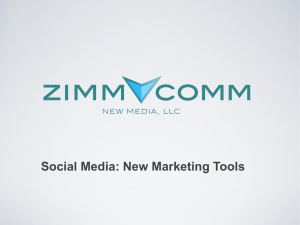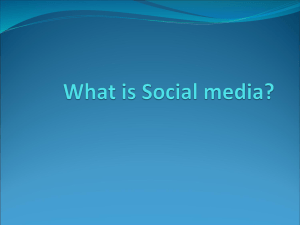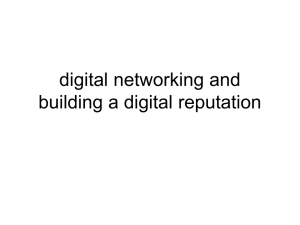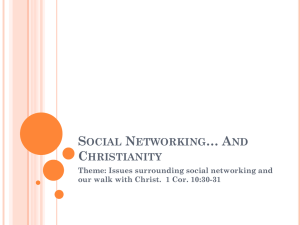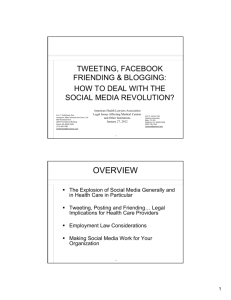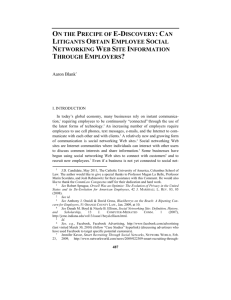Twitter This: Social Media and Hospitals
advertisement
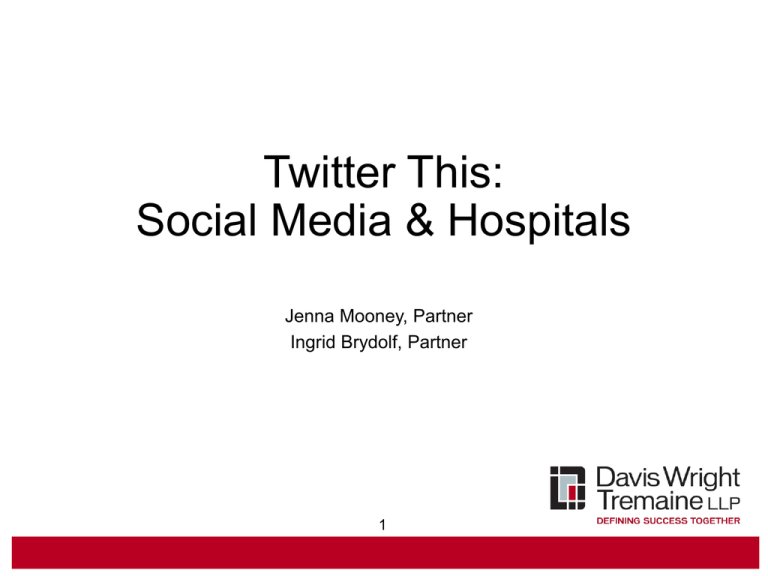
Twitter This: Social Media & Hospitals Jenna Mooney, Partner Ingrid Brydolf, Partner 1 Overview Social media can be useful to providers: What is it? How is it being used? Providers have legal obligations. Providers should be proactive with maintaining control over content and establishing institutional policies on appropriate use. 2 What is Social Networking? Broad range of Internet activities Texting Chat rooms Emails Blogging Videos Easily accessible Work computers Home computers Mobile smartphones and other devices Inherent risks Immediacy Global reach Searchable “Email is Forever” Expectation of a dialogue 3 Online Social Networking Exploding Facebook >400 million users worldwide 2009 revenue: >$550 million 8 billion minutes spent on Facebook each day Increasing corporate marketing use Twitter “Tweets” – max. of 140 characters Celebrity usage – Lance Armstrong, Brittany Spears Corporate use growing exponentially Over 55 million users / month and growing Largest user demographic: 35-49 4 Online Social Networking Exploding LinkedIn Facebook for professionals Over 50 million registered users MySpace Similar to Facebook Less than half the users at over 100 million YouTube Online videos Blogs The original social networking tool Non-provider hosted sites (external sites) Different legal obligations may arise when a provider hosts blogs and other media on its own servers 5 What’s in it for Health Care Providers? April 2010: Hospitals have established: 250 YouTube channels 300 Facebook pages 400 Twitter accounts Social Media is useful to Providers: Launch innovative advertising/marketing campaigns Provide patients & families with information Remain competitive with other providers that have established social media presences. Use in hiring and firing staff? Possible discrimination claims? 6 Legal Obligations: Confidentiality Providers are ‘covered entities’ under HIPAA & state law Affirmative legal obligation to safeguard protected patient information Patient names, addresses, email addresses Creating social media content does not implicate privacy laws as long as providers do not post patient information without authorization 7 Legal Obligations: Practice of Medicine Interactions with patients Malpractice risk Disclaimers (character limits with some media) Licensure issues Privacy Boundary issues 8 Legal Obligations: Disclaimers Given informal nature of social media, providers can remind online visitors that posts are public: “This is a public site. Please do not post personal information about yourself or others, including medical information.” Note: outside scope of this presentation, but with institution-hosted media (e.g., blogs), a more complete terms & conditions notice may be appropriate. 9 What’s in it for Health Care Providers? Can you say 11,000,000 hits? 10 11 12 13 14 15 16 17 18 19 Administrative Controls Wide range of administrative controls available to providers that establish social media presence Facebook: Content posting restricted to page administrators only (public cannot post content) Closed group – persons must formally request to “join” group before having posting access 20 21 22 Employee (Mis-)Use of Social Networks For personal purposes, at work For personal purposes, impacting your business Bad-mouthing the company Trade secrets theft Harassment At work, for business purposes Monitoring comments on hospital services Answering consumer questions Promoting services / education Research 23 Why Health Care Providers Should Care 61% of employees say that even if employers are monitoring their social networking activities, they won’t alter behavior 74% of employees believe it is easy to damage a brand’s reputation via social networking sites 53% of employees say “social networking pages are none of an employer’s business.” *Per Deloitte’s 2009 Ethics & Workplace Survey 24 Why Health Care Providers Should Care Only 17% of companies have programs in place to monitor and mitigate reputational risks Only 22% of employers have formal social networking policies *Per Deloitte’s 2009 Ethics & Workplace Survey 25 Employer Injury Injury to corporate reputation Employee "venting" transmitted instantly to ever- growing audience Possible liability for employee postings Defamation Copyright infringement False advertising claims Discrimination/harassment Medical information (HIPAA/GINA) 26 Employer Liability Electronic discovery issues A new kind of “electronically stored information” (ESI) Social media data is typically not stored on employer’s network or system National Labor Relations Act issues Can be “protected, concerted activity” Blogging about unfair employer policies Applies to all employees, not just unionized workers 27 What Should Employers Do? Develop a policy now – don’t wait for the crisis Convene working group to draft: HR Legal IT Marketing PR/Corporate Communications Employee users 28 Social Media Policy Considerations What is your culture? Separate or integrated policy? Allow or block access to social media websites? Distinguish between professional use and personal use? Extent to which provider equipment and networks can be used for social media? What are your needs? Use of social networking to generate business? Use of social networking in hiring / firing process? 29 Social Media Policy Considerations Duty to bargain with unions regarding policy? Cross-reference in other policies? Anti-harassment and nondiscrimination HIPAA/GINA confidentiality Codes of ethics Legal review of proposed employee terminations for social networking activity 30 Social Media Policy Providers should: Adopt a Social Media Policy for employees and staff Educate staff about the contents of the Policy Enforce policy through imposing consequences for violations 31 Social Media Policy: Adopt Policy should: Set rules for what information staff can post and say online Remind and educate staff about obligations – patient privacy, protecting proprietary institutional information Clarify appropriate relationships between staff, patients and the public 32 Social Media Policy: Educate & Enforce Educate: Any policy is only as good as the institutional awareness of it Know the policy; educate staff at hire and push periodic updates Enforce: Follow through with penalties for violations 33 Social Media Policy: Provisions & Examples Policy statement: “Employees can use social media for business-related purposes subject to restrictions in this Policy to ensure compliance with legal requirements and institutional policies.” Scope of policy – separate provisions for institution-hosted and externally hosted sites. 34 Social Media Policy: Provisions & Examples Rules for use: Maintain patient privacy Respect patients and other staff – no libelous or defamatory speech Safeguard proprietary institutional information Comply with copyright, trademark and other law Do not communicate on “behalf” of institution No patient-specific medical advice 35 Questions? 36
